There has been discussion regarding what receiver is best; stamped or milled. To tell the truth, I had no idea which is better, but I felt that having a milled receiver CIA C39V2 would indicate to me what I liked best.
A quick phone call to my local gun shop was made. I was informed that the shop had just received five CIA C39V2 rifles in along with a larger selection of CIA firearms. A short while later I was drooling at the counter with anticipation. The first example I was shown had a loose upper hand guard. The lower hand guard wood-to-metal mismatch on the second example that I looked at dropped it from consideration. The third example; however, was just right. After a more detailed inspection; the necessary 4473 was completed, money changed hands, and the selected CIA C39V2 went out the door with me.THE BASICS:
The Century International Arms C39V2 is a semi-automatic, gas-operated 7.62x39mm modern sporting variant of the Kalashnikov-based platform AK47. Unlike the AK47, the C39V2 is not “select fire” nor is it an “assault” weapon. Also unlike the AK47, the C39V2 does not incorporate a bayonet lug or cleaning rod and has other design considerations that will not satisfy the AK purist. However, the C39V2 does have design changes that will make the modern sport shooting enthusiast at least sit up and take notice:
WOOD and STEEL:
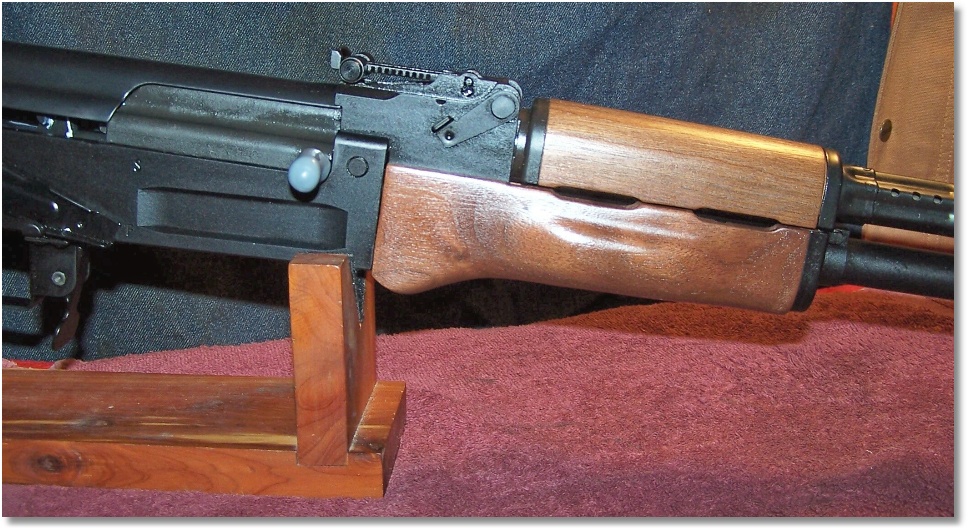 The Nitride finish is uniform throughout the external and internals of the C39V2. The Nitride finish adds an appealing look to the firearm while providing maximum protection.
The Nitride finish is uniform throughout the external and internals of the C39V2. The Nitride finish adds an appealing look to the firearm while providing maximum protection.
The Chrome moly 4150 Nitride treated 16.5-inch barrel comes with a 1:10 twist and concentric LH 14×1 metric thread and ready for a variety of muzzle attachments. A proprietary “chevron” muzzle break adorns the muzzle and is locked into place by a captive pin, which when pressed inward, allows the removal of the muzzle attachment while also serving to lock the muzzle attachment in place.
The receiver is milled 4140 ordinance quality steel and is very nicely finished inside and out. The dust cover is thicker than standard AK dust covers and that means less flexing of the dust cover.
One thing that impressed me was the uniformity of the receiver. There were also no depressions where the rivets meet the receiver, as seen on many stamped AK receivers of import re-builds. Outwardly, it seems that CIA has stepped up its quality game.
CIA has chosen walnut finished furniture on the C39V2 as compared to the blonde finished wood furniture on the RAS47. The stock and upper hand guard seem to be of the same piece of wood while that lower hand guard has a definite change in grain and color. The existing wood furniture is nicely matched to the metal with no gaps between wood and metal. While the edges of the wood could have been rounded off to blend in with the metal to which it is attached, the wood-to-metal fit is better than most AKs that I have come across. CIA has done a most admirable job with the C39V2. The fore-grip, as with the RAS47, has an excellent shape to it that fits the working hand quite nicely. The stock has a sling attachment built in. There is; however, no provision for an AK cleaning kit; it is not something that concerns me, really. Length of Pull (LOP) is 13-inches and that is about 1-inch to short for me, but I have a solution for that (see PERSONAL UPGRADES). The dark wood is appealing on the C39V2.
One thing about the C39V2 (as with the RAS47) is that it is AKM furniture compatible.
SIGHTING SYSTEM:
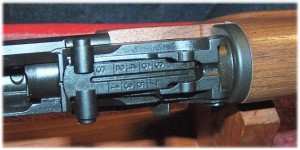 One of the complaints with earlier sighting systems, especially with the adjustable rear sight of the C39, is that the rear sight fell apart under fire. That was not good. CIA has upgraded the rear sight on the C39V2 to a sliding-scale rear sight similar to that found on the Mosin-Nagant and SKS rifles. The RAS47 also uses the same sight. To elevate the sight, push in on the two side locking tabs and slide the scale forward as needed. 800 meters is the highest setting. The rear v-notch is a sight for sore eyes because my eyes get sore when using it. The rear sight sits forward of the receiver and is not unlike many other sights on long guns.
One of the complaints with earlier sighting systems, especially with the adjustable rear sight of the C39, is that the rear sight fell apart under fire. That was not good. CIA has upgraded the rear sight on the C39V2 to a sliding-scale rear sight similar to that found on the Mosin-Nagant and SKS rifles. The RAS47 also uses the same sight. To elevate the sight, push in on the two side locking tabs and slide the scale forward as needed. 800 meters is the highest setting. The rear v-notch is a sight for sore eyes because my eyes get sore when using it. The rear sight sits forward of the receiver and is not unlike many other sights on long guns.
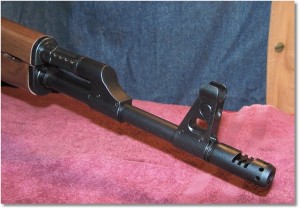 The front sight is fully adjustable (with the appropriate sight tool) for windage and elevation. From the factory, no sight adjustment was necessary (see, RANGE TIME).
The front sight is fully adjustable (with the appropriate sight tool) for windage and elevation. From the factory, no sight adjustment was necessary (see, RANGE TIME).
I think that it is important to interject some information about the RAS47 rear sight, which is also common to the AKM and SKS rear sight with minor differences.
The rear-most notch of the sight is called the “Battlefield Zero” position. When the sight is in this position, it is the same height as the “3” mark on the sliding scale. This essentially means that it is at the same height as a 300-meter zero. Sliding the rear sight to the “1” position drops the rear sight for a 100-meter zero. Consequently, sliding the scale to the “2” position slightly raise the rear sight and sets the rifle for a 200-meter zero. In battle, the soldier was to leave the rear sight in the “Battlefield Zero”, which allowed him or her to engage targets from 300-meters and less without adjusting the rear sight for each estimated distance. The soldier would simply use the necessary “Kentucky” elevation adjustment on the target to compensate for varying distances. The logic behind this was that if the soldier aimed at the midsection of the target, from close range out to 300-meters, it would result on a hit on a 16” target that was anywhere within the window of UCAP and 300-meters distance.
SAFETIES:
 The C39V2 incorporates the ubiquitous lever safety on the right side. A right-handed operator may have difficulties reaching the lever without changing the grip on the rifle. Of course, there are aftermarket safeties on the market that alleviate this problem of reaching the safety without changing one’s grip on the gun.
The C39V2 incorporates the ubiquitous lever safety on the right side. A right-handed operator may have difficulties reaching the lever without changing the grip on the rifle. Of course, there are aftermarket safeties on the market that alleviate this problem of reaching the safety without changing one’s grip on the gun.
The safety prevents the bolt from being pulled to the rear when the hammer is down and blocks the trigger when the hammer is cocked. The bolt; however, can be operated with the hammer cocked and the safety in the up position. A cut-out in the safety lever allows the operator to lock back the bolt, which is a two-handed operation; a handy feature when the range demands an open bolt when off the firing line.
I need to interject information regarding a lawsuit against Century Arms regarding a safety issue. I am not going to go into detail as details can be read here: http://www.outdoorhub.com/news/2016/02/09/century-arms-sued-5-million-defective-ak-47-safety-levers/. While it appears that the safety lever malady involved imported AK rifles that were converted from select fire to semi-automatic fire only (The lawsuit involves the Century Model 1980 chambered in 7.62x39mm and not other models that I am aware of), the internals of the safety lever on the C39V2 does not come close to the Trigger Sleeve and will not cause the hammer to fall should the safety lever be moved to a vertical position. If any ND occurs, it is the operator’s fault and not the firearm.
I will say that the C39V2 does not suffer from safety issues with the exception of it being hard to manipulate when new – especially from the “Safe” position to the “Fire” position. However, a highly delicate engineering approach solved the stiff safety issue – it was bent outward ever so slightly by hand and I can now operate the safety with the thumb of the “working” hand.
INTERNALS:
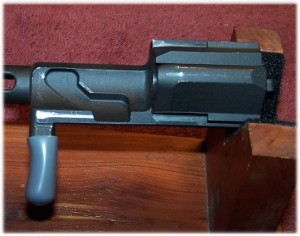 The Bolt carrier is heat treated to ensure maximum performance and life and is a phosphate treated item. The bolt is robust and ensures positive extraction of spent cartridges. The firing pin is free-floating. Both the Extractor and Firing Pin are held into place by pins and can be easily removed and installed by a competent operator with the proper tool to do so.
The Bolt carrier is heat treated to ensure maximum performance and life and is a phosphate treated item. The bolt is robust and ensures positive extraction of spent cartridges. The firing pin is free-floating. Both the Extractor and Firing Pin are held into place by pins and can be easily removed and installed by a competent operator with the proper tool to do so.
Bolt action is very smooth even when new. A dab of quality grease in all the right places makes the action smoother still.
Wolf springs are used throughout the C39V2, including the RAK-1 Enhanced Trigger Group. I am not sure if the Wolf XP (Extra Power) recoil spring is used but one is on order and will be used when it comes time to change out the recoil spring.
The front and rear trunnions on AK firearms seem to be an object of consideration when it comes to wear. Front and rear trunnions are cast items and replaceable component on stamped receivers. On milled receivers; however, they are an integral part of the receiver. Trunnions are subject to the forces of recoil (rear) and chambering (front). The front trunnion is what guides and helps to rotate the bolt into place for complete lockup. The rear trunnion blocks the bolt carrier’s rearward movement while serving as a mounting point for the stock, recoil spring guide assembly, and the rear of the dust cover. What can prevent damage to the trunnions? Ensure that the recoil spring is in excellent shape and proper lubrication of metal-to-metal contact points of the front trunnion. I have no concerns with the trunnions installed on the C39V2. As with the SKS rifle, if the bolt carrier is battering the rear of the receiver, you have a serious weak recoil spring issue in most cases. I’m sure that this applies to many, if not all, semi-automatic firearms that utilize recoil springs.
The hammer is another design that is interesting. The hammer design deviates from standard AK hammer designs in that it has been reshaped to allow a smoother transition of the bolt carrier’s rearward movement to cock the hammer and also to allow a smooth transition from the bolt carrier’s rearmost position forward to chambering a fresh round.
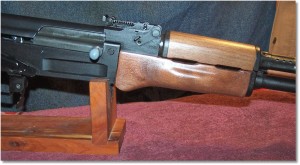 The upper hand guard gas tube is ported and there is a reason for that; the AK is over-gassed. Hot gases are, of course, sent upward in the gas port of the barrel. The hot gases push against the end of the gas rod, which pushes the gas rod rearward against recoil spring pressure. Once the head of the gas rod clears the gas block, pressure is relieved by the gas ports and further movement of the bolt carrier and bolt rearward is against the recoil spring tension. The gas ports simply allow hot gases to escape from the hand guard area into the atmosphere instead of being trapped within a closed gas tube.
The upper hand guard gas tube is ported and there is a reason for that; the AK is over-gassed. Hot gases are, of course, sent upward in the gas port of the barrel. The hot gases push against the end of the gas rod, which pushes the gas rod rearward against recoil spring pressure. Once the head of the gas rod clears the gas block, pressure is relieved by the gas ports and further movement of the bolt carrier and bolt rearward is against the recoil spring tension. The gas ports simply allow hot gases to escape from the hand guard area into the atmosphere instead of being trapped within a closed gas tube.
The bolt carrier also has lightning cuts to reduce the weight of the bolt carrier. The bolt carrier is phosphate coated, unlike many that are chrome-plated, to prevent corrosion.
TRIGGER GROUP:
The C39V2 incorporates the Century International Arms RAK-1 Enhanced Trigger Group. This is a step-up, in my opinion, from the trigger found in the original C39.
- 100% American made single stage trigger group with machined release surfaces that offers a smooth and consistent trigger pull unlike anything you will find on standard AK triggers.
- The top profile of the hammer has been optimized to eliminate the bolt carrier hang up that occurs frequently with other hammers and provides a smoother operation without the need of polishing the hammer.
- The trigger uses a double hook design with an innovative relief cut which allows it to be used in receivers designed to only accept single hook triggers. This gives the operator the option to have the strength and control of a double hook trigger in firearms originally designed to only accept single hook triggers.
- The disconnector has also been optimized to eliminate trigger slap and “folding” of the engagement surface seen on many other trigger groups during high round count tests.
The RAK-1 Enhanced Trigger Group has been properly heat treated and hardened to minimize wear and passed a 15,000 round endurance test. - Each trigger group will include a Hammer, Trigger and Disconnector which count as three U.S. 922r compliant parts. The RAK-1 Enhanced Trigger Group will also include a Hammer Spring, Disconnector Spring and a Trigger Sleeve which allows the Trigger/Disconnector to be pre-assembled before dropping into the rifle.
- The RAK-1 is a great upgrade to any AK style rifle while maintaining the traditional reliability of a stock trigger.
- The RAK-1 fits the WASR, C39, RAS47, AK63D and many other AK rifle and pistol variants.
Read more about the trigger in RANGE TIME.
MAGAZINES AND MAGAZINE RELEASE:
The C39V2 accepts all standard AK magazines and comes with one 30 rd. PMAG magazine in approved states. Otherwise, two 10-round magazines are furnished with the rifle. I actually like the 10-round magazines for range work when bench resting and reserve large capacity magazines for large capacity work. Ammunition for this beast may be inexpensive as compared to most, but it is still an expense and I am not one for performing magazine dumps at high rates of fire.
The magazine release lever has been extended on the C39V2 and that is welcomed by many. An extended T-bar release is used and this allows positive removal of magazines using the “tactical” method of releasing a magazine (banging the replacement magazine against the magazine release lever and then slapping the expended magazine from the magazine well). Magazines lock up in a positive manner and release in the same manner. Since I am a left-handed operator, my right hand works all the essential control like the safety and magazine release lever while the shooting hand maintains a constant grip on the handle.
Magazines in the C39V2 lock up tight as compared to the RAS47. Milled receivers allow for tighter tolerances over stamped receivers and this is quite evident in the magazine well. I have read numerous mentions of how this peeves people off like there is nothing worse in the world than a loose fitting AK magazine. Considering that a slightly loose fitting magazine contributes to the overall reliability of the firearm should make them rethink their position. And, considering that most magazines for the AK are not precision devices, I think that some slack should be cut in this area considering the loose tolerances that the AK is built to, and while not adding to the accuracy tree, certainly keeps the bullets a-flying while other rifles are a-jamming due to too tight tolerances when operating in the mud, the blood, and the fear.
WEIGHT:
Due to the milled receiver, the C39V2 is heavier that its counterpart the RAS47. The C39V2 weighs in at 8.05 pounds dry and unloaded; whereas, the RAS47 is 0.50 pounds lighter at 7.55 pounds of dry unloaded weight. Not to worry because I’m still a manly-man. If I feel weak and wimpy on any day, I’ll go with the AR.
PERSONAL UPGRADES:
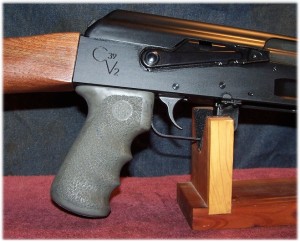 Prior to range time, two upgrades were made. The first was replacing the pistol grip with the Hogue Over-molded rubber grip with finger grooves. While I installed a black Hogue grip on the RAS47, I decided to install a “Ghillie Green” on the C39V2 to add a more personal touch. While the pistol grip that came with the C39V2 is probably adequate for most operators, it does not fill my hand the way I liked. In five minutes time, the grip was exchanged with the Hogue unit and is much more to my preference for a pistol grip.
Prior to range time, two upgrades were made. The first was replacing the pistol grip with the Hogue Over-molded rubber grip with finger grooves. While I installed a black Hogue grip on the RAS47, I decided to install a “Ghillie Green” on the C39V2 to add a more personal touch. While the pistol grip that came with the C39V2 is probably adequate for most operators, it does not fill my hand the way I liked. In five minutes time, the grip was exchanged with the Hogue unit and is much more to my preference for a pistol grip.
While not being the prettiest butt pad ever made, it certainly does the job for extending the LOP to a desired length and also assists in managing felt recoil. The UTG AK47 Combat Butt Pad is a heavy, rubber unit that is nicely textured at the shoulder end to provide a secure purchase. Five slits in the pad provides additional cushioning. The overall 5.25-inch length provides a nice footprint against the shoulder to help distribute the push of the recoil.
The unit slides easily over the stock and also removes just as easily. Some have complained about this, but I see it as an advantage. If I am wearing heavy outer clothing, I can elect to remove the butt pad should the LOP be too long. Conversely, I can place it on the firearm should I need it. Granted, an adjustable butt stock may serve me better, but at what cost? The unit just doesn’t fall off the stock like some would lead you to believe; it does mount securely for the most part. Besides, I have yet to find an adjustable buttstock that does not move around when the firearm is mounted. The UTG AK47 Combat Butt Pad provides a sold feel and I like that. The UTG AK47 Combat Butt Pad also protects the base of the buttstock from damage. I also like that.
The UTG AK47 Combat Butt Pad, coupled with the Hogue over-molded pistol grip, makes the C39V2 a pleasure to shoot.
A sling may be added in the future, but I am undecided at this point. Although I do have a sling for the AK, I may opt for one intended for the SKS rifle, as the leather attachments allow for somewhat quick detachment from the firearm and would also keep scratches to the Nitride finish to a minimum.
OTHER PERSONAL UPGRADES:
In short, there are no other personal upgrades nor are any planned for the future. Unlike the RAS47, the C39V2 does not come equipped with a side rail for mounting an optic, upon which is mounted (at times) a Midwest Industries AK Railed Scope Mount with American Defense Throw Lever and the UTG 6.4″ ITA Red/Green CQB Dot Sight with 1-piece QD Rings. It is obvious to me that a decent optic would make a difference for these old eyes. However, I have no problems with the sights that come with the C39V2, they are adequate for my intended use for the C39V2, and I have no plans to add an optic in the future.
UPDATE: Since my purchase of the C39V2, Century Arms now incorporates a side rail, upon which you can mount an optic rail, and upon which you can mount your choice of optic. The Red Army Standard optic mount seems to be a good choice and my opinion is shared by others.
RANGE TIME:
Since the range day with the RAS47, I acquired a few more boxes of different ammunition and would run them in the C39V2:
- Brown Bear 123-grain HP (AB762HP)
- Silver Bear 123-grain HP (A762HPN)
- Golden Bear 123-grain HP (AG782HP)
- Monarch 123-grain FMJ
- Fiocchi 124-grain FMJ
- Wolf Polyformance 123-grain FMJ
With the exception of the Fiocchi brand, all ammunition was steel case (Golden Bear is brass coated steel). Ten rounds of each were to be fired, which I hoped to give me a good indication of how the C39V2 was going to perform.
I used a silhouette targets placed at 25-yards distance (the limit of my local indoor range). Bench resting dictates the use of short magazines.
As with the RAS47, no offhand shooting for this first session, because I needed to know where my bullets would impact with as solid a hold as only bench-resting can provide without locking the firearm in place. Point of aim was the same for each target – center of the bulls-eye as close as I could place it. Since my local indoor range is not renowned for its bench rest equipment, I had to make do with what I could put together on my own, which meant using my rolled up hunting jacket laying on top of my gun case as I did with the RAS47. Not a solid shooting support by any means, but much better than my off-hand shooting.
The object here was simply test for functioning and zero.
The top of the front sight is real close to 2” from the center line of the bore as I could measure. At this sight height, and at 25-yards, and for a 100-yard zero, the bullet would need to impact the target 1.59 inches below the X; my POA on the target.
Silver Bear 123-grain was the first round up and a three-shot group revealed that rounds were impacting just slightly high and ever so slightly right (about ½”) of the “X” that was my POA. There was really no need to touch the front sight. The Golden Bear ammunition shot excellent as did the Brown Bear. I have no complaint about either. The Golden Bear, with its brass coated steel, is my preferred of the three “Bear” ammunition. The WPA also performed well and without incident.
As with the RAS47, the Fiocchi 124-grain FMJ bullet was providing the tightest grouping and least amount of felt recoil. Head shots were POA (or close enough for government work) and were trustworthy for quick-aim, point-n-shoot occasions. I really like the Fiocchi ammunition for the AK. If the RAS47 or C39V2 were selected as house guns, the Fiocchi 7.62×39 HP ammunition would be my desired load due to its tightest grouping and least amount of felt recoil.
As with the RAS47, overall felt recoil is very mild. Given the gas-pistol powered system; an excellent Wolf recoil spring, an additional half-pound of weight due to the milled receiver, and the UTG AK47 Combat Butt Pad, felt recoil was no problem at all. The 7.62x39mm cartridge is not a powerhouse of a cartridge; the muzzle does jump a bit, but is relatively easy to get back on target after firing.
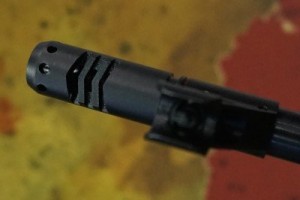 One caveat with the C39V2, that I have, is the proprietary muzzle break. The proprietary chevron muzzle break does a good job in keeping the muzzle steady, but it does have more bark than the canted muzzle break on the RAS47 and a lot more muzzle flash. I am undecided, at this point, if I will change the muzzle break out for a canted or other design. For indoor range work, I may install the canted break and save the proprietary chevron muzzle break for outdoor work. A little more trigger time with the C39V2 will determine any changes. Muzzle flash at night with the proprietary chevron muzzle break would definitely affect ones night vision.
One caveat with the C39V2, that I have, is the proprietary muzzle break. The proprietary chevron muzzle break does a good job in keeping the muzzle steady, but it does have more bark than the canted muzzle break on the RAS47 and a lot more muzzle flash. I am undecided, at this point, if I will change the muzzle break out for a canted or other design. For indoor range work, I may install the canted break and save the proprietary chevron muzzle break for outdoor work. A little more trigger time with the C39V2 will determine any changes. Muzzle flash at night with the proprietary chevron muzzle break would definitely affect ones night vision.
As with the RAS47, saying that the RAK-1 Enhanced Trigger Group is an upgrade is an understatement. While I have not shot a lot of AK firearms, I have pulled the triggers on quite a few in my wandering among them. The RAK-1 Enhanced Trigger Group is the smoothest of any trigger that I have encountered on any AK to date – and that includes the TAPCO V2.
Once past the initial take-up the trigger is consistently smooth until the hammer falls. There is no “wall” so it is difficult to discern, at times, the trigger break-point. With the RAK-1 trigger system, I realized that the “grittiness” that you find in some triggers was simply not there. Also not there was the trigger slap that is common to some of the AK rifles, and that made my trigger finger really happy.
The near 5-pound trigger pull (10-pull average) is what I consider close to the optimum trigger pull weight for a firearm used for defensive and sporting purposes. For precision work the trigger is lacking, but the C39V2 is not meant for precision work. The triggers on the RAS47 and the C39V2 are virtually identical in operation and performance.
Always a concern for left-handed operators is how, and in what direction, a firearm expels expended casings. I experienced no problems with the C39V2 extracting and ejecting expended case; they all went out the right way and in the right direction. If anything, I was bonked on several occasions from spent shells bouncing off the wall of the lane in which I was firing, but all spent casings (I learned a lesson in thumb placement of the support hand with the RAS47) were expeditiously expelled well out to the side of the ejection port.
 As with the RAS47, my last point about the range experience is with operating the safety. I am a left-handed operator of long guns and, in being so; it would seem that I am at a disadvantage in some respects with running right-handed rifles. With the C39V2, or any AK for that matter, any disadvantage is minimal when operating the safety – I simply use the thumb of my right (working) hand. Given that my working hand is in close proximity of the magazine, if not holding on to it, I simply extend my thumb to the safety lever and push it up (safe) or down (fire) as needed. The left hand (the shooting hand) never changes its position on the pistol grip, nor do I have to remove the butt of the RAS47 from my shoulder. With the “working hand” I can also release and install magazines very quickly. At the range it is; push safety up (safe), release the magazine, remove the magazine, install the new magazine, push safety down (fire), rack the charging handle and I am ready to shoot again. The trigger finger is resting on the bottom edge of the trigger guard or somewhere out of the trigger guard. In real-life encounters, safety lever operation is dictated by conditions.
As with the RAS47, my last point about the range experience is with operating the safety. I am a left-handed operator of long guns and, in being so; it would seem that I am at a disadvantage in some respects with running right-handed rifles. With the C39V2, or any AK for that matter, any disadvantage is minimal when operating the safety – I simply use the thumb of my right (working) hand. Given that my working hand is in close proximity of the magazine, if not holding on to it, I simply extend my thumb to the safety lever and push it up (safe) or down (fire) as needed. The left hand (the shooting hand) never changes its position on the pistol grip, nor do I have to remove the butt of the RAS47 from my shoulder. With the “working hand” I can also release and install magazines very quickly. At the range it is; push safety up (safe), release the magazine, remove the magazine, install the new magazine, push safety down (fire), rack the charging handle and I am ready to shoot again. The trigger finger is resting on the bottom edge of the trigger guard or somewhere out of the trigger guard. In real-life encounters, safety lever operation is dictated by conditions.
The UpLula loader for the AK47/AK74 is almost a necessity when loading (and unloading) 10-round or 30-round magazines and one was purchased for use with the RAS47. It now serves double-duty for loading magazines for the C39V2. Pull the lever up and push it rearward, place the front of the loader in the front groove of the magazines, snap the rear latch into place, roll the lever forward to press the magazine follower down, and simply drop the first round into the magazine. Roll the lever back to load the second cartridge. Then, continue rocking and rolling (I use my thumb and forefinger) until the magazine is full. Lift the rear catch off of the magazine, lift the loader up and forward to remove the loader from the magazine. Repeat on subsequent magazines. When finished, pop the lever down to its storage position.
Granted that the preferred method of unloading a magazine is to shoot the contents, but there may be times when unloading the magazine manually is more preferred – such as for cleaning or storing the magazine empty. Unloading a magazine is just as simple; however, the lever should be positioned to the rear at the beginning of unloading the magazine. Rock the lever back and forth and the contained cartridges virtually fall from the magazine when the loading chute of the magazine is facing downward.
Loading and unloading magazines with the UpLula is quite boring, actually.
Solid, polymer construction makes the Magazine Loader, Lula, AK47/Galil easy to carry and easy to use. A small ring on the base of the unit allows you to attach the unit to a clip, if desired.
Whether you load an occasional magazine for range use or a lot of them for warfare, training, or competition use you owe it to yourself to have one (or more) of these Lula loaders.
I was well pleased with this first range outing with the C39V2; The C39V2, as did the RAS47, ran without a malfunction.
FINAL OPINION:
 The Century International Arms C39V2, like its counterpart the stamped receiver RAS47, is a fine example of the Kalashnikov-based long gun sans bayonet lug and cleaning rod. In short, the CIA C39V2 is a civilian version of a popular firearm’s platform. It is well constructed of premium parts that are all made in the U.S.A.
The Century International Arms C39V2, like its counterpart the stamped receiver RAS47, is a fine example of the Kalashnikov-based long gun sans bayonet lug and cleaning rod. In short, the CIA C39V2 is a civilian version of a popular firearm’s platform. It is well constructed of premium parts that are all made in the U.S.A.
My only reserve is the short WARSAW PACT-length stock that came with the firearm. Folks who are stocky with short arms probably won’t have a complaint, but long-armed folks like me feel really cramped when shooting the CIA C39V2 and other guns like it (including the SKS and Mosin-Nagant rifles). Of course, that is easily rectified by adding a slip-on recoil pad or NATO-length stock to increase the LOP. With that said, it is far easier to exchange a slip-on recoil pad according to seasonal clothing or gear demands, in my opinion.
When it comes down to it, the rear sight is no further from my eyes than would be if I held a handgun at full arm’s length. The sight radius is right at 14 7/8-inches and is not than much different from many carbines like the Ruger 10/22 or .30-30 carbine. In fact, the rear sight is closer than holding a handgun at arm’s length. In bright daylight, I have no problem with the sights as they are. With indoor range lighting; however, lining up the sights is a challenge. However, that is me and not the AK; a dab of white sight paint on the front sight may be all that is needed.
So, where does this CIA C39V2 fit into my scheme of things? I am developing an affinity with the platform due to its simplicity. The CIA RAS47 opened the door for me to explore the platform, and in doing so, probably finds me leaning to American-made firearms of the same platform – if they are of the quality that I am seeing with the 100% American Made products from Century International Arms.
In my mind, the Century International Arms C39V2 is a well made representation of the Kalashnikov platform that allows me to enjoy it for what it is – a sporting firearm. No changes are planned for it aside from upgrades mentioned in this article and I really don’t want to get caught up in the AK upgrade madness. The Century International Arms C39V2 is a fine example of a lightweight, affordable carbine and that is the way I wish to keep it. As with the CIA RAS47, the C39V2 is considered as an entry-to-mid level AK.
In getting back to the issue of milled vs. stamped receivers, I still don’t know which is better. However, what I do know and what does warm the cockles of my heart is the fact that the C39V2 and the RAS47 are both completely “Made in the U.S.A.” firearms and that they are worth the investment (IMHO).
If you have not considered a carbine of the Kalashnikov platform, perhaps you should. The Century International Arms 100% American made C39V2 just might be a good start.
ONE OVER THE OTHER:
Personally, I like dark wood furniture on my firearms and the C39V2 appeals to my like. Although I do like the blonde finish of the RAS47, I may opt to refinish the furniture with a stain to my liking and which would fit the personality of the RAS47 better.
Both the C39V2 and the RAS47 are aesthetically-pleasing firearms, as everything seems to blend together well. The inward-swept gas block adds a windswept appearance to the firearm that ends with the nicely-sloped angle of the dust cover but continues on to the butt of the rifle.
Both the C39V2 and the RAS47 are a pleasure to shoot and accuracy seems to be about the same in both firearms. Anyone who has fired a .308/7.62x51mm cartridge for any length of time would feel that they are on vacation when shooting either of these firearms.
THE “DON’T JUST TAKE MY WORD FOR IT” SECTION:
There are plenty of resources available for garnering information on the C39V2 and you should take advantage of them, if you are deciding whether the C39V2 from Century International Arms is a workable firearm for you:
- Century Arms C39V2 AK-47 Rifle Review and it is 100% American Made: http://www.majorpandemic.com/2015/05/century-arms-c39v2-ak-47-rifle-review.html
- Scot’s Product Review: Century Arms C39V2 AK 47: https://survivalblog.com/scots-product-review-century-arms-c39v2-ak-47/
- Century C39V2 No BS Review! Is it Epic Fail or Working Gun?: https://www.youtube.com/watch?v=SI_NAM0G1K4
- Century C39 V2 Milled AK (Iraqveteran8888): https://www.youtube.com/watch?v=1iJTU_D1nd0
- Century Arms C39 V2 AK (Hickock45): https://www.youtube.com/watch?v=UAMiqJm6li0
- C39 V2 US Made AK-47 Review (SOOTCH00): https://www.full30.com/video/e99620919fabbace67ed1da58f8aed1e
RESOURCES:
- Product ID: RI2245-N, Red Army Standard C39v2 Semi-Auto Rifle, Cal. 7.62x39mm: http://www.centuryarms.biz/proddetail.asp?prod=RI2245-N&cat=134
- Century International Arms RAK-1 Enhanced Trigger Group: https://www.youtube.com/watch?v=XWteayyDfds
- UTG Combat Butt Pad: http://www.amazon.com/gp/product/B002TUSK06?psc=1&redirect=true&ref_=od_aui_detailpages00
- Hogue Oversize Monogrip for AK47 and AK74: http://www.midwayusa.com/product/553804/hogue-overmolded-pistol-grip-ak-47-ak-74
![]()



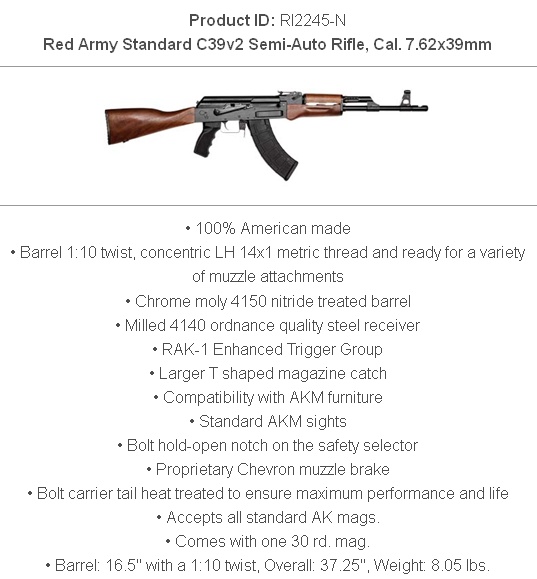
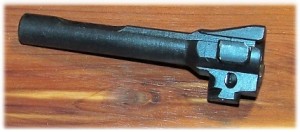

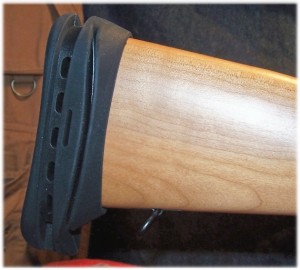
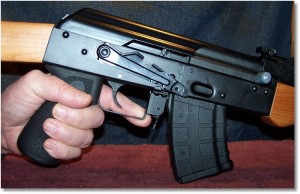

2 Responses to Warming Up to the Kalashnikov Platform, Part 2 – The CIA C39V2